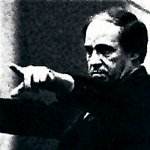S & H Concert Review
Varese, Bartok, Stravinsky: Maurizio Pollini (pf), London Symphony orchestra, Pierre Boulez, Barbican, 11th October 2002 (AR)
VARESE Integrales
BARTOK Piano Concerto No 1
STRAVINSKY Firebird Ballet (complete 1910)
Varese’s Intégrales for 11 wind instruments and percussion, played by a fragment of the London Symphony Orchestra, was given in a performance that was both athletic and precise. Although Boulez’ conducting was tight but expansive the subtlest of hand gestures sufficed to elicit a perfect response from the players; the effect was to draw out the tension between the silence and the sound in an electrifying way. It is hard to imagine this radical work being given a more definitive performance, with conductor and orchestra completely in unison in realising this intimate but intense composition.
After their vigorous and highly concentrated playing of the Varese, Bartok’s Piano Concerto No. 1 was somewhat anticlimactic. In the opening of the Allegro moderato, minimal attention was given to the dialogue between the piano and the timpani: and in a work where this is crucial the concerto began less compellingly than it might have done. Bartok’s intention was for the soloist to be an extension of the percussion section whereas with Pollini’s performance the effect to place him against a background of audible wallpaper. The use of ‘soft sticks’ by the timpanist further sublimated the percussiveness which an ideal performance requires. Pollini’s playing was undoubtedly polished yet his rather soft-core tone seemed at variance with Bartok’s metallic and percussive soundscape. Playing in an almost nineteenth century romantic manner Pollini projected the image of being out of touch with Bartok’s abrasive style whereas Boulez conjured the LSO in to playing with hard-edged dissonance and corporate attack; aided by the conductor’s rhythmically taught and rigorously tight direction it was entirely Bartokian in its idiom. There was some notably fine playing, particularly from the rasping, muted trombones and the pointedly characterful woodwind but ultimately the performance gave the impression of pianist and orchestra being slightly at cross-purposes.
The highlight was a spellbinding account of Stravinsky's Firebird in its complete 1910 version. Concert performances of ballet scores are often more revealing of the composer’s original intentions because the conductor is unconstrained by having to adjust tempi to suit the dancers. What Boulez achieved in this riveting performance was to make the score sound more like a symphonic poem than a ballet.
The quiet, throbbing ‘cellos at the opening brilliantly set the scene in Kashchey’s magic garden and prepared us for the unfolding of one of Russia’s great fairy-tales. Boulez’ elegant conducting, with meaningful hand gestures, underlined why this is such a wonderful score as he guided the orchestra through the glittering, dramatic passages and the interspersed, quiet lyrical interludes, such as the exquisite berceuse. The LSO strings were ecstatic and ethereal in tone, while the woodwind rose admirably to the challenges of Stravinsky’s score playing with dazzling agility. The flautists in particular really shone while the horn solo was pure magic.
Central to the performance was the vigorous playing of the bass drum, which made several members of the audience flinch. Such intense, even nerve shattering, bass drum playing is relatively rare in the concert hall and gave the performance a pointed malevolence. If the effect was to make us feel rather than hear the performance, unintentional or otherwise, this was all for the better. If there was a weakness in this otherwise divinely played, paradigmatic performance of the Firebird it was the rather passive playing of the timpanist.
Alex Russell

 Return to:
Return to: